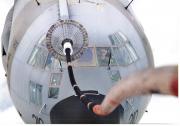So bizarre.
Slide walls arenít to contain blasts.
Thatís what barrel chambers are for.
The only pressure slam the slide sees is BREECH FACE backwards.
So if you were asking about breech face thickness, sure.
Or barrel chamber thickness, sure.
But slide walls?
Riddle me this.
If it took any side loading, donít you think youíd see a lot of slide side abrasion?
So youíre asking about this area?
Your question would be valid if your barrel was made out of rubber, lol.
The pressure is contained in the barrel chamber.
The slide walls donít see it.
Breech face does get hammered but not exploded.
Case base contains that.
If the slide walls saw pressure through the walls of the barrel chamber, youíd see marks on the slide walls from friction in a shot up gun.
I still feel like maybe Iím misunderstanding what youíre asking because itís like asking why Dodge used a certain hood sheet metal thickness when the explosions are in the engine.
As another data pointÖ
Have you ever shot a Glock with a thumb over the back plate to prevent the slide from cycling?
It actually doesnít take much force to do so.
Even the breech face isnít getting super slammed because the case is pressed against it at ignition by the recoil spring and locking lugs of the barrel.
Breech face is also reinforced laterally in the unsupported area (yellow).
The red area doesnít see pressure.
Thatís my best understanding of how a semiauto works, anyway.
I could be wrong.
If you took a revolver and extended the question, the cylinder chamber would be like the barrel chamber and there is no slide thickness at all! Just the frame below and above. To the rear where the case is, pressure on breech face but if you held the rear of cylinder when firing (if you avoided cylinder gap to barrel in the front), your fingers would be fine. No pressure.




 Reply With Quote
Reply With Quote




